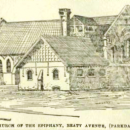
From the Anglican Church of the Epiphany to Our Lady of Lebanon Maronite Church
In the story of the development of Anglican parishes in the west end of Toronto, many roads lead back to the parish of St. Anne’s, Brockton (now St. Anne’s, Gladstone). In 1876 (before St. Barnabas, Halton was carved out of the parishes of St. Anne’s and St. Matthias’), the mission parish of St. Mark’s was established. This parish, located to the south and slightly to the west of St. Anne’s on Cowan Avenue (just south of Queen) is what is known today as the Church of the Epiphany & St. Mark, Parkdale.
In 1887, a new parish was carved out of St. Mark’s — the Church of the Epiphany. The new parish, located just half a mile west of St. Mark’s, was created (at least in part) in response to residential growth in the village of Parkdale, which had recently been annexed by the city of Toronto. Epiphany’s first parishioners were from St. Mark’s, and their first meeting place was the Parkdale Masonic Hall (located at Queen and Dowling in a building which still exists and is now apartments). In September 1888, the first Church of the Epiphany was opened on a lot on the south-west corner of Queen Street and Beaty Avenue (west of Lansdowne).
The first building was not intended to be the long-term building used for worship, but rather was to be converted to Sunday school use after funds could be raised for a larger building. It sat 300 and was “an exceedingly plain building both in its exterior and interior.” The architects were Strickland and Symons of Aberdeen Chambers, Toronto. The original Church of the Epiphany still exists, and is now used as a parish school. Only its north facade can be easily seen as it is hemmed in on all other sides by housing and the rest of the church buildings. By 1910, the parish was strong enough to build its intended larger space, in order “to meet the future needs of a rapidly-growing district.” The corner stone was laid in 1910 and the parish moved into its new space on 31 March 1911. This building, with a seating capacity of 1000 or more, exists today. It was designed by Henry Bauld Gordon, who also was the architect of Church of the Messiah, Toronto and the parish hall at St. Anne’s, Gladstone. (A tower was part of the architectural design but never built.)
There was one more chapter in the history of Epiphany buildings with the addition of a parish hall in 1930. This space is also now used as part of the parish school. Its east facade is visible from Beaty Avenue. The history of the parish reflects the changing demographics of the neighbourhood. In the late nineteenth and early twentieth century, the neighbourhood was teeming with church-going Anglicans, enough to establish a massive new building such a short distance from St. Mark’s. By mid-century, there appears to be the signs of, or at least concern about, decline. By the 1960s, with demographic changes in the neighbourhood and societal changes at play, Epiphany seemed determined to survive.
Many parishioners no longer live in the parish but continue to return to keep the parish going and active. In the 1970’s there were conversations about amalgamation with its mother church, St. Mark’s, and St. Judes’ on Roncesvalles. Many parishioners no longer live in the parish but continue to return to keep the parish going and active. In the 1970’s there were conversations about amalgamation with its mother church, St. Mark’s, and St. Judes’ on Roncesvalles.
By the early 1980’s the parish community was small and the massive buildings in need of substantial repairs. On Palm Sunday 1983 the Church of the Epiphany held its final service. A decision was taken to sell the building and amalgamate Epiphany back into its mother parish of St. Mark’s. The funds from the sale were used to refurbish the buildings and the new, amalgamated parish of Epipany & St. Mark’s was born, 96 years after St. Mark’s had given birth to the Church of the Epiphany. The buildings were sold to the Maronite community, and began their new life as Our Lady of Lebanon Maronite Catholic Church.
Description of the church building from the archives of the City of Toronto:
The property at 1515 Queen Street West, known historically as the Church of the Epiphany, is identified for architectural reasons. It is an important feature of the south side of Queen Street West between Beaty Avenue and Wilson Park Road. There are three structures on the property. The original church was built in 1888, the second church in 1910-1911, and the Parish Hall in 1929. The latter two buildings, both erected according to the design of the Toronto architectural firm of Gordon and Helliwell. The first Church of the Epiphany was constructed in 1888 by the Toronto architectural firm of Strickland and Symons and is still situated on the southwest corner of the property. At the time of construction this church was not intended to be used permanently for divine service. It is no longer used by the congregation. The second Church of the Epiphany was erected on the northeast corner of the site. Constructed on a basilican plan and featuring elements of the Gothic Revival style, the brick church is highlighted by stone detailing. The main (north) elevation features raised, centrally placed double doors surmounted by a large tudor window containing perpendicular tracery. The east and west corners of this elevation have stepped angle buttresses. The northeast corner is marked by a 2-storey tower containing a side entrance. The east elevation is four bays in length and is marked by single stepped buttresses. Each bay contains a single raised basement window surmounted by a tudor arched window with perpendicular tracery. To the south, a transept arm contains two bays marked by large tudor arched windows. The west elevation has an aisle entrance, is five bays in length has a transept arm of two bays in width, and shares the fenestration and but east elevation. The clerestory contains tudor arched windows. The south elevation of the church features a large window which contains perpendicular tracery. A gabled and shed roof cover the various portions of the building. The church interior comprises a narthex, a nave with side aisles, and a raised chancel. The aisles are separated from the nave by an arcade consisting of slender columns. An open wooden beam roof covers the nave while lower wooden roofs cover the aisles. The church contains 19th Century stained glass windows executed by the Toronto firm of Robert McCausland Limited. Adjoining the southern elevation is a 2½-storey polygonal Parish Hall with a raised basement. The openings on the first and second stories have paired trefoil windows and are highlighted by stone sills and lintels. A polygonal roof covers the building.
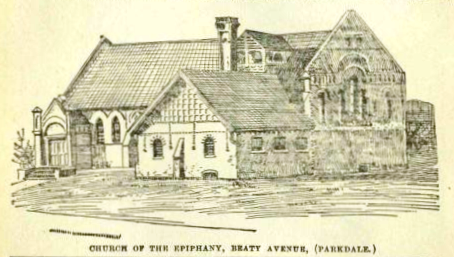




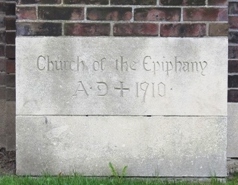
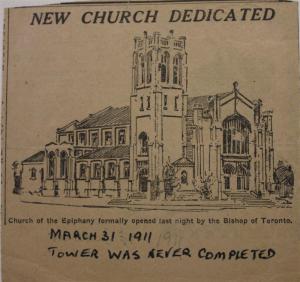
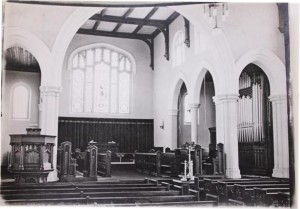
No comments yet.
Only registered users can comment.